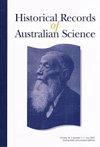约翰·达拉奇(1804-71):在罗金汉湾采集植物标本
IF 0.4
4区 哲学
Q4 HISTORY & PHILOSOPHY OF SCIENCE
引用次数: 1
摘要
警告这篇文章的读者被警告,它可能包含对原住民和托雷斯海峡岛民具有文化敏感性和/或冒犯性的术语、描述和意见。约翰·达拉奇(1804-71)于1864-71年受雇于费迪南德·冯·穆勒男爵,作为昆士兰罗金汉湾卡德威尔的先驱居民收集植物。Dallachy是穆勒任职时间最长的有偿植物收藏家,也是穆勒大型收藏家网络中最多产的收藏家。Dallachy的成功部分归功于他的收集方法和在物种丰富的罗金汉湾地区的密集旅行。在某种程度上,Dallachy也感谢欧洲拓荒者的支持(这在新分类群的同名中得到了承认),以及当地土著和南海岛民。Dallachy在边境战争的背景下管理着这些关系,因为当地土著人拒绝被欧洲殖民者驱逐。尽管如此,Dallachy有机会成为一名全职专业植物收藏家,他的新标本被鉴定和出版的速度之快,在很大程度上要归功于Mueller。与穆勒的合作使达拉奇从罗金汉湾向墨尔本植物标本馆捐赠了约3500个标本,其中约400个分类群被认为是西方科学的新分类群。本文章由计算机程序翻译,如有差异,请以英文原文为准。
John Dallachy (1804–71): collecting botanical specimens at Rockingham Bay
Warning
Readers of this article are warned that it may contain terms, descriptions and opinions that are culturally sensitive and/or offensive to Aboriginal and Torres Strait Islanders.
John Dallachy (1804–71) was employed by Baron Ferdinand von Mueller to collect plants as a pioneer resident of Cardwell, Rockingham Bay, Queensland, 1864–71. Mueller’s longest-serving paid botanical collector, Dallachy was also the most prolific collector of types among Mueller’s large network of collectors. In part, Dallachy’s success can be attributed to his collecting methods and intensive travels around the species-rich Rockingham Bay area. In part, also, Dallachy was indebted to fellow European pioneers for support (which was acknowledged in the eponymy of new taxa), and to local Indigenous and South Sea Islander people. Dallachy managed these relationships in a context of frontier war as local Indigenous people resisted being displaced by European colonists. Nevertheless, Dallachy’s opportunity to work as a full-time professional botanical collector, and the rapidity with which his new specimens were identified and published was, to a large extent, due to Mueller. The partnership with Mueller led to Dallachy contributing ~3500 specimens from Rockingham Bay to the Melbourne Herbarium of which ~400 taxa were considered new to Western science.
求助全文
通过发布文献求助,成功后即可免费获取论文全文。
去求助
来源期刊

Historical Records of Australian Science
HISTORY & PHILOSOPHY OF SCIENCE-
CiteScore
0.90
自引率
66.70%
发文量
22
期刊介绍:
Historical Records of Australian Science is a bi-annual journal that publishes two kinds of unsolicited manuscripts relating to the history of science, pure and applied, in Australia, New Zealand and the southwest Pacific.
Historical Articles–original scholarly pieces of peer-reviewed research
Historical Documents–either hitherto unpublished or obscurely published primary sources, along with a peer-reviewed scholarly introduction.
The first issue of the journal (under the title Records of the Australian Academy of Science), appeared in 1966, and the current name was adopted in 1980.
 求助内容:
求助内容: 应助结果提醒方式:
应助结果提醒方式:


